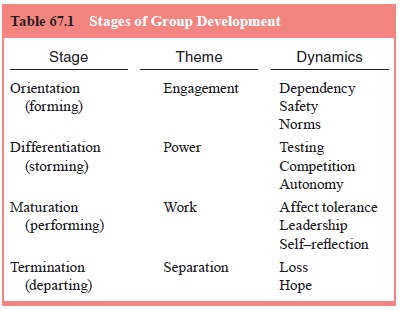Chapter: Essentials of Psychiatry: Group Psychotherapy
Group Psychotherapy: Group Development
Group
Development and Group Dynamics
The basic
science informing group treatment is group develop-ment and dynamics.
Understanding of these concepts provides a foundation for the therapist’s
integration of individual, interper-sonal and intrapsychic dynamics with those
of group member-ship (Table 67.1).

Group
Development
The seminal work of Bennis and Shepard (1956) produced a spate of studies demonstrating that groups have a natural developmen-tal sequence. Groups must accomplish certain tasks as they move from a collection of individuals to a functioning and working or-ganization. In this discussion, the focus is on developmental se-quences in groups conducted along psychodynamic principles
Initial (Engagement, Orientation) Phase
Individuals
entering a psychotherapy group are faced with two ma-jor tasks: they have to
decide how they will use the treatment to accomplish their goals and
simultaneously they have to determine the limits of emotional safety. Members
turn to the therapist in hope of gaining information on how to proceed. They
anticipate that the leader, a person they already know and who fulfills a
traditional role, will provide guidance and smooth the way in getting to know
the strangers in the room. In the main, these “dependency” strivings are
frustrated. Members tentatively reveal themselves to others. Gradu-ally,
unwritten and primarily unconscious rules (norms) develop, which help contain
anxiety and set standards for acceptable behav-ior. Therapists help shape behavior
by providing information on how to proceed and by clarifying (interpreting)
underlying anxieties. Common themes and concerns may be highlighted, which
serve to diminish members’ sense of isolation and enhance cohesion.
Reactive (Power, Differentiation) Phase
Many
groups move into this phase by rebelliously rejecting their leader. This may be
followed by a relatively short-lived sense of well-being and harmony. However,
norms are often experienced as restrictive and members may begin to feel as
though they are controlled by the group (group tyranny). In response, they
assert individuality and demonstrate their own power. Struggles be-tween
members emerge, and angry exchanges are not uncommon. Usual norms against
expression of intense intragroup affects are tested and modified in accordance
with members’ personal ca-pacities. Some members may threaten to quit, or they
remain si-lent during this phase as they grapple with their ability to tolerate
conflict. The therapist assists in helping members understand and tolerate
responses to intense feelings and differences.
Mature (Working) Phase
In this
phase, groups have developed considerable cohesion. Members can tolerate
differences and they can contain anxi-ety and allow conflicts to emerge without
having to interrupt exchanges. They have learned to provide and receive
feedback from others without undue defensiveness. A considerable por-tion of
the group transactions is focused on the here and now, and exchanges are
appreciated as containing both reactions to the present and vestiges from prior
relationships (transferences). Members attempt to understand one another at
both surface and in-depth levels. The therapist no longer is the sole expert,
and members are valued for their emotional and cognitive unique-ness.
Therapists continue to help patients understand their in-group reactions and
assist in broadening their perspectives to include the sources (genetic) of
their feelings and their manifesta-tions in their outside world.
Termination Phase
Ending
treatment is the final stage. It is filled with mixed feelings: those of
success and looking to the future and those surrounding separations (Schermer
and Klein, 1996). Often there is a regres-sion as anxieties over departing are
addressed. This provides an additional opportunity to explore the problems that
emerge. Members respond with pleasure at seeing someone “graduate”, but they
also experience loss of a valued contributor to the work and envy over a
colleague’s achievement. A successful termina-tion also offers hope for those
who remain. The therapist monitors the dynamic forces and enables members to
say their farewells within a context of therapeutic accomplishments and
continuing psychological work. In the process, remaining members experi-ence
and integrate their responses to the departure.
Summary
Groups do
not uniformly traverse these developmental phases, and they undergo shifts to
earlier stages under stress, such as vacations or change in membership. A
considerable amount of therapeutic work takes place at each developmental
level. For in-stance, a group of individuals experiencing problems with basic
trust may spend a good deal of time in an initial stage, where these feelings
may be explored. Patients who need to address competitive feelings may
alternate between the reactive and the working phases. Understanding group
development provides a framework for therapists to appreciate the forces that
have an im-pact on members’ feelings and behavior.
Related Topics